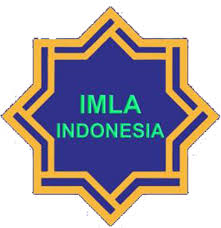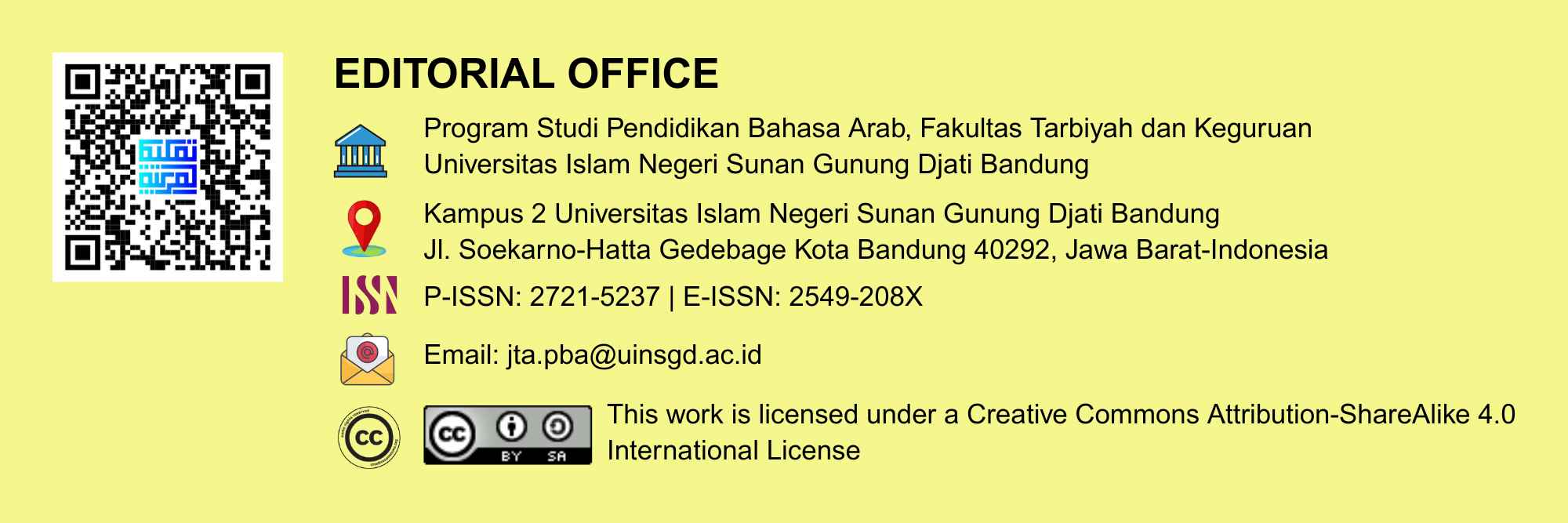Rhetorical Move and Language Feature Analysis on Multilingual Research Article Abstracts Across English, Indonesian, and Arabic Languages in Islamic Studies
DOI:
https://doi.org/10.15575/jta.v9i1.44663Keywords:
Contrastive linguistics, Genre analysis, Islamic studies, Research article abstractAbstract
Research article abstracts play a critical role in academic communication, particularly in Islamic education, as they serve as a gateway for readers to access and evaluate scholarly contributions. This study investigates the rhetorical moves and linguistic features of trilingual paired abstracts (English, Indonesian, and Arabic) in Islamic studies research articles. Using a corpus-based approach and contrastive linguistic analysis, the study examines how authors structure their abstracts and employ linguistic strategies across these three languages. The findings reveal that all three languages follow Hyland’s five-move framework, with Moves 2 (Purpose), 3 (Method), and 5 (Conclusion) being the most common. In contrast, Move 4 (Product) emerged as obligatory across the corpus. At the step level, Step 8 (context and procedures) dominated in the Method move, and Steps 6 and 7 were prevalent for Move 3, while Steps 11 and 12 were rarely used in Move 5. Linguistically, there is a consistent preference for the present tense and active voice, with English abstracts heavily favoring the present tense and Indonesian abstracts relying on non-conjugated verbs. These results have practical implications for language departments in Islamic higher education institutions, guiding the development of academic writing curricula. They also offer insights for researchers in Islamic studies to craft effective abstracts and manuscripts aligned with international academic conventions.
References
Al Farisi, M. Z. (2023). Acceptability of the Quran Translation. Al-Jami’ah: Journal of Islamic Studies, 61(2), 329–363. https://doi.org/10.14421/ajis.2023.612.329-363
Alharbi, L. M., & Swales, J. M. (2011). Arabic and English Abstracts in Bilingual Language Science Journals: Same or Different? Languages in Contrast, 11(1), 70–86. https://doi.org/10.1075/lic.11.1.06alh
Alhuqbani, M. N. (2013). Genre-Based Analysis of Arabic Research Article Abstracts Across Four Disciplines. Journal of Educational and Social Research, 3(3), 371–382. https://doi.org/10.5901/jesr.2013.v4n3p371
Alotaibi, H. (2015). Metadiscourse in Arabic and English Research Article Abstracts. World Journal of English Language, 5(2), 1–8. https://doi.org/10.5430/wjel.v5n2p1
Al-Shujairi, Y. B. (2021). Review of the Discussion Section of Research Articles: Rhetorical Structure and Move. LSP International Journal, 8(2), 9–25. https://doi.org/10.11113/lspi.v8.17099
Amnuai, W. (2019a). Analyses of Rhetorical Moves and Linguistic Realizations in Accounting Research Article Abstracts Published in International and Thai-Based Journals. Sage Open, 9(1), 2158244018822384. https://doi.org/10.1177/2158244018822384
Amnuai, W. (2019b). Rhetorical Move Structures and Linguistic Realizations of Abstracts in ICT Research Articles and Master’s Theses. Connexion: Journal of Humanities and Social Sciences, 8(1), 157-184. Retrieved from https://so05.tci-thaijo.org/index.php/MFUconnexion/article/view/241189.
Bouziane, A., & Metkal, F. E. (2020). Differences in Research Abstracts written in Arabic, French, and English. English Studies at NBU, 6(2), 233–248. https://doi.org/10.33919/esnbu.20.2.4
Chalak, A., & Norouzi, Z. (2013). Rhetorical Moves and Verb Tense in Abstracts: A Comparative Analysis of American and Iranian Academic Writing. International Journal of Language Studies, 7(4), 101-110. Retrieved from https://www.ijls.net/pages/volume/vol7no4.html.
Curry, N., Baker, P., & Brookes, G. (2024). Generative AI for Corpus Approaches to Discourse Studies: A Critical Evaluation of ChatGPT. Applied Corpus Linguistics, 4(1), 100082. https://doi.org/10.1016/j.acorp.2023.100082
Darabad, A. M. (2016). Move Analysis of Research Article Abstracts: A Cross-Disciplinary Study. International Journal of Linguistics, 8(2), 125–140. https://doi.org/10.5296/ijl.v8i2.9379
Ghasempour, B., & Farnia, M. (2017). Contrastive Move Analysis: Persian and English Research Articles Abstracts in Law. Journal of Teaching English for Specific and Academic Purposes, 5(4), 739–753. https://doi.org/10.22190/JTESAP1704739G
Hanidar, S. (2016). Rhetorical Patterns, Verb Tense, and Voice in Cross Disciplinary Research Article Abstract. Humaniora, 28(1), 12–27. https://doi.org/10.22146/jh.11410
Hashemi, M. R., & Gohari Moghaddam, I. (2019). A Mixed Methods Genre Analysis of the Discussion Section of MMR Articles in Applied Linguistics. Journal of Mixed Methods Research, 13(2), 242–260. https://doi.org/10.1177/1558689816674626
Hilmi, A. Z., & Afifi, N. (2021). A Genre Analysis on the Discussion Section of Quantitative and Qualitative Research Articles in ELT and Linguistics. JEELS (Journal of English Education and Linguistics Studies), 8(2), 341–369. https://doi.org/10.30762/jeels.v8i2.3264
Jasim Al-Shujairi, Y. B., Sani Ya’u, M., & Abdul Azeez Buba, J. (2016). Role of Moves, Tenses, and Metadiscourse in the Abstract of an Acceptable Research Article. Mediterranean Journal of Social Sciences, 7(2), 379–386. https://doi.org/10.5901/mjss.2016.v7n2s1p379
Kafes, H. (2012). Cultural Traces on the Rhetorical Organization of Research Article Abstracts. International Journal on New Trends in Education and Their Implications, 3(3), 207-220. Retrieved from http://www.ijonte.org/FileUpload/ks63207/File/20.kafes.pdf.
Khasanah, S. N., & Baehaqie, I. (2021). The Comparison of the Formation of Indonesian and Arabic Plural Meanings (Contrastive analysis). Jurnal Arbitrer, 8(1), 25–34. https://doi.org/10.25077/ar.8.1.25-34.2021
Kheryadi, K., Muin, A., & Syahid, A. H. (2022). Hedges in English and Arabic Metadiscourse Utility in Academic Writing: A Contrastive Analysis. Jurnal Al Bayan: Jurnal Jurusan Pendidikan Bahasa Arab, 14(2), 308–323. https://doi.org/10.24042/albayan.v14i2.12144
Kurniawan, E. (2023). Humanities Dissertation Abstracts in Indonesian and English Universities: A Comparative Move Analysis. GEMA Online® Journal of Language Studies, 23(2), 57–74. https://doi.org/10.17576/gema-2023-2302-04
Kurniawan, E., & Lubis, A. H. (2020). A Comparative Move Analysis on the Qualitative and Quantitative Findings and Discussion Sections Written by EFL Undergraduate Students. Asian ESP Journal, 16(6), 137-162. Retrieved from https://www.researchgate.net/publication/348097912.
Kurniawan, E., & Sabila, N. A. A. (2021). Another Look at the Rhetorical Moves and Linguistic Realizations in International and Indonesian Journal Articles: A Case of Tourism Research. Indonesian Journal of Applied Linguistics, 11(2), 318–329. https://doi.org/10.17509/ijal.v11i2.32055
Ma’suq, A. T., Huda, M. M., & Irawan, B. (2024). Analysis of Syntactic Errors in Arabic Textbook-Based Instructional Materials and Their Implications for Arabic Learning at Madrasah Aliyah. Ta’lim al-’Arabiyyah: Jurnal Pendidikan Bahasa Arab & Kebahasaaraban, 8(1), 85–102. https://doi.org/10.15575/jpba.v8i1.33580
Muangsamai, P. (2018). Analysis of Moves, Rhetorical Patterns and Linguistic Features in New Scientist Articles. Kasetsart Journal of Social Sciences, 39(2), 236–243. https://doi.org/10.1016/j.kjss.2018.03.006
Nabilla, S., Luthfianda, S. N., Suherdi, D., Kurniawan, E., Gunawan, W., & Lubis, A. H. (2021). How Do Novice and Experienced Indonesian Authors Rhetorically Organize Research Article Introduction? 502–507. https://doi.org/10.2991/assehr.k.210427.076
Neilson, T., Levenberg, L., & Rheams, D. (2018). Introduction: Research Methods for the Digital Humanities. In L. Levenberg, T. Neilson, & D. Rheams (Eds.), Research Methods for the Digital Humanities (pp. 1–14). Springer International Publishing. https://doi.org/10.1007/978-3-319-96713-4_1
Nikmah, K. (2020). Interrogative Sentence: A Contrastive Study of Arabic and Indonesian. Izdihar: Journal of Arabic Language Teaching, Linguistics, and Literature, 2(3), 183–200. https://doi.org/10.22219/jiz.v2i3.10148
Nurcik, A. B., Kurniawan, E., & Lubis, A. H. (2022). Rhetorical Moves Analysis on Scopus-Indexed Research Article Abstracts by National and International Authors. English Review: Journal of English Education, 10(2), 349–358. https://doi.org/10.25134/erjee.v10i2.6235
O’Keeffe, A., & McCarthy, M. (2010). The Routledge Handbook of Corpus Linguistics (Vol. 10). Routledge.
Pratiwi, S. N., & Kurniawan, E. (2021). Rhetorical Move and Genre Knowledge Development of English and Indonesian Abstracts: A Comparative Analysis. Studies in English Language and Education, 8(3), 885–900. https://doi.org/10.24815/siele.v8i3.21038
Ruiying, Y., & Allison, D. (2003). Research Articles in Applied Linguistics: Moving from Results to Conclusions. English for Specific Purposes, 22(4), 365–385. https://doi.org/10.1016/S0889-4906(02)00026-1
Sabila, N. A. A., & Kurniawan, E. (2020). Move Analysis of Tourism Research Article Abstracts in National and International Journal Articles: Proceedings of the 4th International Conference on Language, Literature, Culture, and Education (ICOLLITE 2020), 514–520. https://doi.org/10.2991/assehr.k.201215.080
Sanah, S., Bustomi, J., Azhar, R. S., & Saad Bahaaeldin, M. (2024). A Content Analysis of Al-Kitab Al-Asasi The Lens of Rushdi Ahmad Thu’aimah’s Theories. Ta’lim al-’Arabiyyah: Jurnal Pendidikan Bahasa Arab & Kebahasaaraban, 8(2), 350–365. https://doi.org/10.15575/jpba.v8i2.40629
Sultan, A. H. (2011). A Contrastive Study of Metadiscourse in English and Arabic Linguistics Research Articles. Acta Linguistica, 5(1), 28-41. Retrieved from https://www.actalinguistica.com/arhiv/index.php/als/article/view/354.
Swales, J. M., & Feak, C. B. (2012). Academic Writing for Graduate Students: Essential Tasks and Skills (Vol. 3). University of Michigan Press, Ann Arbor, MI.
Tamela, E. (2020). Move Structure Analysis on Research Article Abstracts in National and International SCOPUS Indexed Journals. Proceedings of the International Conference on English Language Teaching (ICONELT 2019), 434, 12–17. https://doi.org/10.2991/assehr.k.200427.004
Tawalbeh, A. (2019). The Rhetoric Of Accounts Of Methodology In English And Arabic Educational Research Articles: A Contrastive Genre Analysis [Doctoral Thesis, University of Huddersfield]. Retrieved from https://eprints.hud.ac.uk/id/eprint/35068/
Tocalo, A. W. I. (2021). Move Structures and Their Rhetorical Verbs of Research Article Abstracts Across Englishes. Indonesian Journal of Applied Linguistics, 11(1), 1–10. https://doi.org/10.17509/ijal.v11i1.34593
Tu, P., & Wang, S.-P. (2013). Corpus-Based Research on Tense Analysis and Rhetorical Structure in Journal Article Abstracts. Proceedings of the 27th Pacific Asia Conference on Language, Information, and Computation (PACLIC 27), 102-107. Retrieved from https://aclanthology.org/Y13-1008.pdf.
Vathanalaoha, K., & Tangkiengsirisin, S. (2018). Genre Analysis of Experiment-based Dental Research Article Abstracts: Thai and International Journals. 3L The Southeast Asian Journal of English Language Studies, 24(3), 1–14. https://doi.org/10.17576/3L-2018-2403-01
Yudhiantara, R. A., Kurniawan, E., & Al Farisi, M. Z. (2024). A Metadiscourse Analysis of Research Article Abstracts Across English, Indonesian, and Arabic Authored by Indonesian Islamic Higher Education Scholars. Jurnal Pendidikan Islam, 10(2), 260–279. https://doi.org/10.15575/jpi.v10i2.39165
Downloads
Additional Files
Published
How to Cite
Issue
Section
Citation Check
License
Copyright (c) 2025 Rully Agung Yudhiantara, Eri Kurniawan, Mohamad Zaka Al Farisi

This work is licensed under a Creative Commons Attribution-ShareAlike 4.0 International License.
Authors who publish in Ta'lim al-'Arabiyyah: Jurnal Pendidikan Bahasa Arab dan Kebahasaaraban agree to the following terms:
- Authors retain copyright and grant the journal right of first publication with the work simultaneously licensed under a Creative Commons Attribution-ShareAlike 4.0 International (CC BY-SA 4.0) License that allows others to share the work with an acknowledgment of the work's authorship and initial publication in this journal.
- Authors are able to enter into separate, additional contractual arrangements for the non-exclusive distribution of the journal's published version of the work (e.g., post it to an institutional repository or publish it in a book), with an acknowledgment of its initial publication in this journal.
- Authors are permitted and encouraged to post their work online (e.g., in institutional repositories or on their website) prior to and during the submission process, as it can lead to productive exchanges, as well as earlier and greater citation of published work (See The Effect of Open Access).
![]()
Ta'lim al-'Arabiyyah: Jurnal Pendidikan Bahasa Arab dan Kebahasaaraban is licensed under a Creative Commons Attribution-ShareAlike 4.0 International License.
Based on a work at https://journal.uinsgd.ac.id/index.php/Talim







